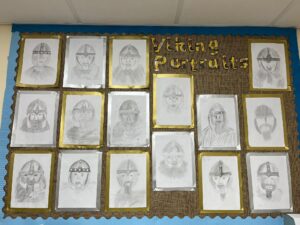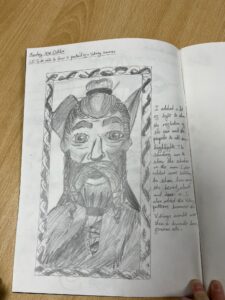- Home
- Welcome
- Parents
- Statutory Information
- SAFEGUARDING
- Curriculum
- Classes
- Catholic Life
- News & Events
- Governors
St. Anne's R.C.
Primary School
Children at St. Anne’s love their Art and DT lessons! At our school, you can find:
We have been working collaboratively to produce pieces of artwork from Nursery – Y6 as part of our reflections in the lead up to Remembrance Day. This is our whole school display:
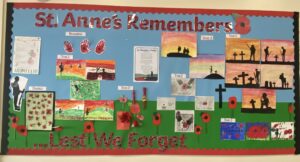
In Nursery, the children have been thinking about Bonfire night – fire work painting, printing and splatter art.
They also made sparklers, using straws and then children chose and snipped shiny paper for fire
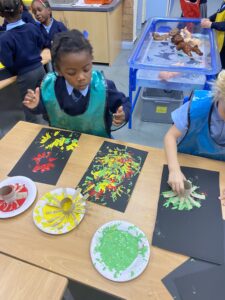
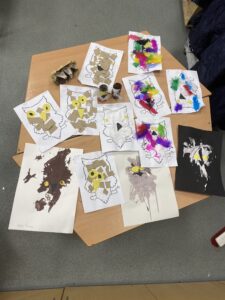
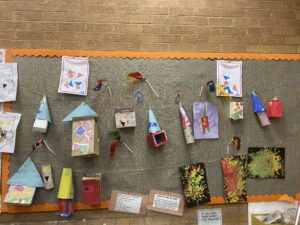
Year 1 objectives:
Year 1 vocabulary:
Drawing: thick, thin, soft, broad, narrow, fine, pattern, line, shape, detail, mirror image, nature, made environment.
Painting: primary (colour), light, dark, thick, thin, tone, warm, cold, shade e.g. different shades of red, green, blue, yellow, bright.
Printing: print, rubbing, smudge, image, reverse, shapes, surface, pressure, decoration, cloth.
Collage & Textiles: fabric, colour, pattern, shape, texture, glue, stick, scissors, sew, needle, felt, hessian, scraps, wool, yarn, thread, fur, tweed, silk, satin, net, weave.
Sculpture: model, cut, stick, fold, bend, attach, assemble, statue, stone, shell, wood, metal.
In Year 1, the children have been designing their own sock puppets.
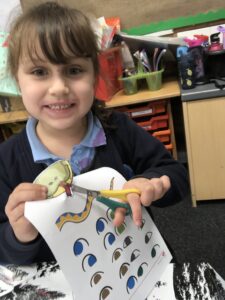
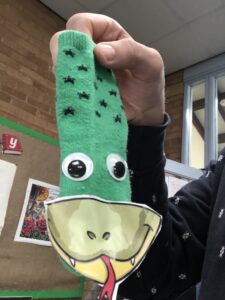
Year 2 objectives:
Year 2 vocabulary:
Drawing: Thick, Thin, Soft, Broad, Narrow, Fine, Pattern, Line, Shape, Detail, Nature, Made environment, Comparison, Still life.
Painting: Secondary (colour), Light, Dark, Thick, Thin, Tone, Warm, Cold, Shade e.g. different shades of red, green, blue, yellow, Bright, Pointillism, Colour wash.
Printing: Print, Rubbing, Smudge, Image, Reverse, Shapes, Surface, Pressure, Decoration, Cloth, Repeat, Rotate, Mon-print, Two-tone print.
Collage & Textiles: Fabric, Colour, Pattern, Shape, Texture, Glue, Stick, Scissors, Sew, Needle, Felt, Hessian, Scraps, Wool, Yarn, Mixed media, Collage, Appliqué, Layers, Combine, Opinion, Thread, Fur, Tweed, Silk, Satin, Net, Weave.
Sculpture: Sculpture, Structure, Assemble, Construct, Model, Fold, Bend, Attach, Statue, Stone, Metal, Curve, Form, Clay, Impress, Texture.
In Year 2, the children have been thinking about saving their oceans and have linked their DT unit to their topic, creating sea creatures from recyclable resources and developing their skills in sculpture.



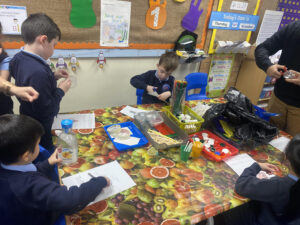
Year 3 objectives:
Year 3 vocabulary:
Drawing: Frame, Cartoon, Comic strip, Map, Position, Boundary, Label, Line, Symbol, Practical, Impractical, Change, Improve.
Painting: Abstract, Natural, Bold, Delicate, Detailed, Colour descriptors e.g. scarlet, crimson, emerald, eau de nil, turquoise, Watery, Intense, Strong, Opaque, Translucent, Wash, Tint, Shade, Background, Foreground, Middle ground.
Printing: Imprint, Impression, Mould, Mono print, Background, Marbling, Surface, Absorb, Stencil, Pounce, Negative image, Positive image.
Collage & Textiles: Tie and dye, Natural, Synthetic, Vat, Bunching, Dip, Soak, Resist, Threading, Stitching, Embroidery, Cross stitch, Running stitch, Stem stitch, Shrunken, Wool tops, Carding, Tease, Matting.
Sculpture: Viewpoint, Detail, Decoration, Natural, Form, Two-dimensional, Three-dimensional, Tiles, Brick, Slate, Wood, Stone, Metal, Texture, Bronze, Iron.
Year 4 objectives:
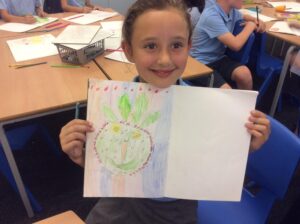
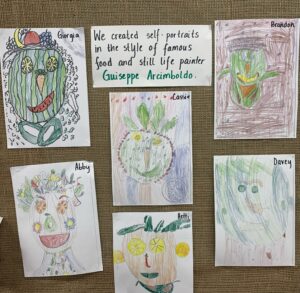
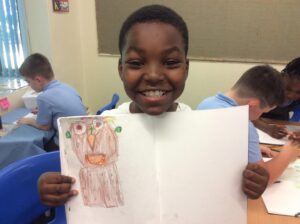
Y5 objectives:
Year 5 vocabulary:
Drawing: Viewpoint, Distance, Direction, Angle, Perspective, Bird’s eye view, Alter, Modify, Interior, Exterior, Natural form, Vista, Panorama, Image, Subject, Portrait, Caricature, Expression, Personality.
Painting: Traditional, Representational, Imaginary, Modern, Abstract, Impressionist, Stippled, Splattered, Dabbed, Scraped, Dotted, Stroked, Textured, Flat, Layered, Opaque, Translucent, Intense.
Printing: Monotype, Printing plate, Inking up, Water-based, Oil-based, Overlap, Intaglio, Relief, Etching, Engraving, Indentation, Collograph, Pressure.
Collage & Textiles: Cloth, Fray, Taffeta, Organdie, Poplin, Tweed, Embellished, Manipulated, Embroidered, Warp, Weft, Replicate, Soft sculpture.
Sculpture: Realistic, Proportion, Surface texture, Balance, Scale, Relationship, Transform, Movement, Rhythm, Composition, Structure, Construct, Flexible, Pliable, Hollow, Solid, Surface, Plane, Angle, Slip, Attachment, Relief.
In Year 5, we have been annotating the work of local graffiti artists Nomad Clan and designing our own 3D sketched graffiti walls, considering tone and shade. We linked our art unit to our history study of the Anglo-Saxons and added an Anglo-Saxon rune to our graffiti walls.

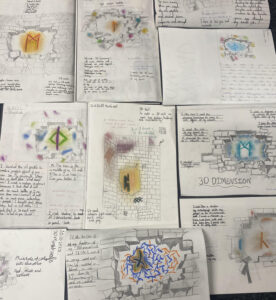

Year 6 objectives:
Year 6 vocabulary:
Drawing: Action, Balance, Direction, Dynamic, Imbalance, Movement, Poised, Transition, Viewpoint, Weight.
Painting: Still life, Traditional, Modern, Abstract, Imaginary, Natural, Made, Inanimate, Composition, Arrangement, Complimentary, Tonal, Shading.
Printing: Aesthetic, Pattern, Motif, Victorian, Islamic, Rotation, Reflection, Symmetrical, Repetition.
Collage & Textiles: Manipulation, Smocking, Ruching, Batik, Embellish, Accentuate, Enhance, Detract, Practicality, Aesthetic.
Sculpture: Line, Shape, Pose, Position, Gesture, Repetition, Sequence, Dynamic, Flowing, Motion, Rhythm, Proportion, Balance
In Year 6, we have been focusing on Viking Art this term. We have been having a look at Viking patterns, Viking animals and drawing Viking Warriors.
